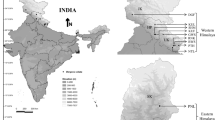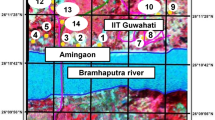Abstract
Random Amplified Polymorphic DNA (RAPD) showed a high degree of polymorphism in nine species of bamboo, Dendrocalamus giganteus Wall ex Munro, D. asper Becker ex K. Heyn, D. longispathus (Kurz) Kurz, Bambusa vulgaris `Striata', B. ventricosa, B. bambos (L.) A. Voss, B. atra Lindley, Gigantochloa atroviolacea Wdjaja and Arundinaria hindsii, in Sri Lanka. The lowest mean genetic distance of 0.143 was between B. vulgaris and B. ventricosa. They could however be distinguished morphologically. The genetic distances separating D. longispathus from D. giganteus and D. asper were both greater than that between the latter two species, which had a value of 0.313. Although the genetic distances between Bambusa vulgaris, B. ventricosa and B. bambos were relatively small, B. atra separated from them at greater distances. The smaller genetic distances between G. atroviolacea and B. vulgaris, B. ventricosa and B. bambos indicated that G. atroviolacea had a closer affinity to these three Bambusa species than B. atra. A. hindsii with the greatest genetic distances from all other species in the study, was not related to any of them. RAPD analysis was useful in determining the genetic diversity and relationships and in detecting problematic generic assignments.
Similar content being viewed by others
References
Armstrong J, Gibbs AJ, Peakall R, Weiller G (1994) The RAPDistance Package. Fttp//life. anu.edu.au/pub/software/RAPDistance or http//life.anu.edu.au/molecular/software/rapd.html (20 Feb 2006).
Bhattacharya S, Das M, Bar R and Pal A (2006). Morphological and molecular characterization of Bambusa tulda with a note on flowering. Ann Bot 98: 529–535
Clark L (1997) Bamboos: the centerpiece of the grass family. In: Chapman GP (ed) The bamboos. Linnaean Society Symposium Series No. 19. Academic, London, pp 237–248
Doyle JJ and Doyle JL (1990). Isolation of plant DNA from fresh tissues. Focus 12: 13–15
Dransfield S, Wdjaja EA (eds) (1995) Plant resources of South-East Asia No. 7. Bamboos. Backhuys, Leiden
Friar E and Kochert G (1991). Bamboo germplasm screening with nuclear restriction fragment length polymorphisms. Theor Appl Genet 82: 697–703
Friar E and Kochert G (1994). A study of genetic variation and evolution in Phyllostachys (Bambusoideae: Poaceae) using nuclear restriction fragment length polymorphisms. Theor Appl Genet 89: 265–270
Geilis J, Everaert I, De Loose M (1997) Genetic variability and relationships in Phyllostachys using random amplified polymorphic DNA. In: Chapman GP (ed) The bamboos. Linnaean Society Symposium Series No. 19. Academic, London, pp 107–124
Huang LC and Huang BL (1995). Loss of the species distinguishing trait among regenerated Bambusa ventricosa McClure plants. Pl Cell Tiss Organ Cult 42: 109–111
Kobayashi M (1997) Phylogeny of world bamboos analyzed by restriction fragment length polymorphisms of chloroplast DNA. In: Chapman GP (ed) The bamboos. Linnean Society Symposium Series No. 19. Academic, London, pp 227–236
Koshy KC and Jee G (2001). Studies on the absence of seed set in Bambusa vulgaris. Curr Sci 81(4): 375–378
Li DZ (1997) The flora of China Bambusoideae project – problems and current understanding of bamboo taxonomy in China. In: Chapman GP (ed) The bamboos. Linnean Society Symposium Series No. 19. Academic, London, pp 61–81
Lin CS, Lai YH, Sun CW, Liu NT, Tsay HS, Chang WC, Chen JJW (2006) Identification of ESTs differentially expressed in green and albino mutant bamboo (Bambusa edulis) by suppressive subtractive hybridization (SSH) and microarray analysis. Pl Cell Tiss Org Cult (in press).
Loh JP, Kiew R, Set O, Gan LH and Gan YY (2000). A study of genetic variation and relationships within the bamboo subtribe Bambusinae using Amplified Fragment Length Polymorphism. Ann Bot 85: 607–612
Nei M and Li WH (1979). Mathematical model for studying genetic variation in terms of restriction endonucleases. Proc Natl Acad Sci USA 76: 5269–5273
Ohrnberger D (1999). The bamboos of the world. Elsevier, Amsterdam
Renvoize SA, Hodkinson TR (1997) Classification of Phyllostachys. In: Chapman GP (ed) The bamboos. Linnean Society Symposium Series No. 19. Academic, London, pp 95–106
Saitu RK and Nei M (1987). The neighbor joining method: a new method for reconstructing phylogenetic trees. Molec Biol Evol 4: 406–425
Stapleton CMA (1997) The morphology of woody bamboos. In: Chapman GP (ed) The bamboos. Linnean Society Symposium Series No. 19. Academic, London, 251–267
Sumithraarachchi DB, Hettige U and de Zoysa N (1993). Bamboos for housing in Sri Lanka, a guide to their identification. Royal Botanic Gardens, Peradeniya, Sri Lanka
Watson L, Dallwitz MJ (1992) The grass genera of the world (revised edition). Cambridge University Press.
Weising K, Kahl G (1997) Hybridization-based micro-satellite fingerprinting of plants and fungi. In: Caetano-Anolls G, Gresshaff PM (eds) DNA markers; protocols, applications and overviews, pp 27–53
Author information
Authors and Affiliations
Corresponding author
Rights and permissions
About this article
Cite this article
Ramanayake, S., Meemaduma, V. & Weerawardene, T. Genetic diversity and relationships between nine species of bamboo in Sri Lanka, using Random Amplified Polymorphic DNA. Plant Syst. Evol. 269, 55–61 (2007). https://doi.org/10.1007/s00606-007-0587-1
Received:
Accepted:
Published:
Issue Date:
DOI: https://doi.org/10.1007/s00606-007-0587-1




